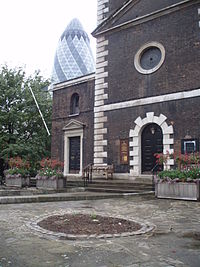Portsoken
| Ward of Portsoken | |
|---|---|
 St Botolph's Aldgate |
|
| Ward of Portsoken shown within Greater London | |
| Population | 985 (2011 Census. Ward) |
| Ceremonial county | Greater London |
| Region | |
| Country | England |
| Sovereign state | United Kingdom |
| Post town | LONDON |
| Postcode district | E1 |
| Postcode district | EC3 |
| Dialling code | 020 |
| Police | Metropolitan |
| Fire | London |
| Ambulance | London |
| EU Parliament | London |
| UK Parliament | |
Portsoken is a historical district in the City of London, located outside the former London Wall, on the eastern part of the City, near Aldgate. It is one of the City's 25 ancient wards.
Aldgate and Tower wards lie to the west, and its eastern boundary is defined by Middlesex and Mansell Streets in Whitechapel. To the north, the boundary meets Bishopsgate and Spitalfields; to the south, the former liberties of the Royal Mint.
The Sir John Cass's Foundation Primary School is now located in this (largely residential) ward, added in the 2003 boundary review, and is the only part of the ward within the former wall.
John Stow's survey of London records that the ‘soke’ (later ‘liberty’) was granted in Saxon times east of Aldgate to a Guild of Knights in exchange, essentially, for regular jousting. Norman kings confirmed these rights but later the land was voluntarily transferred to the Priory of the Holy Trinity by the descendants of the Guild.
In 1120 or 1121 (the exact date is unknown), Portsoken was granted as a liberty to the Priory of Holy Trinity, which had been founded in 1107 by Queen Matilda, the wife of King Henry I. The sitting prior of Holy Trinity became, ex officio, an alderman of the City of London Corporation representing Portsoken ward, and remained so until the Dissolution of the Monasteries by King Henry VIII in 1531.
In 1332, a tax assessment showed 23 taxpayers in Portsoken, however, this figure consisted only of freemen of the City of London who possessed moveable property worth more than 10 shillings, and so did not include the poor, non-citizens, or members of religious orders. A later subsidy roll from 1582 showed that the ward's taxpayers had been assessed to pay a total of 57 pounds, 11 shillings and 4 pence.
...
Wikipedia

